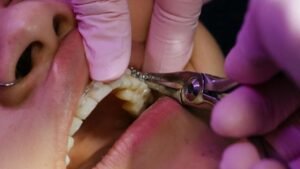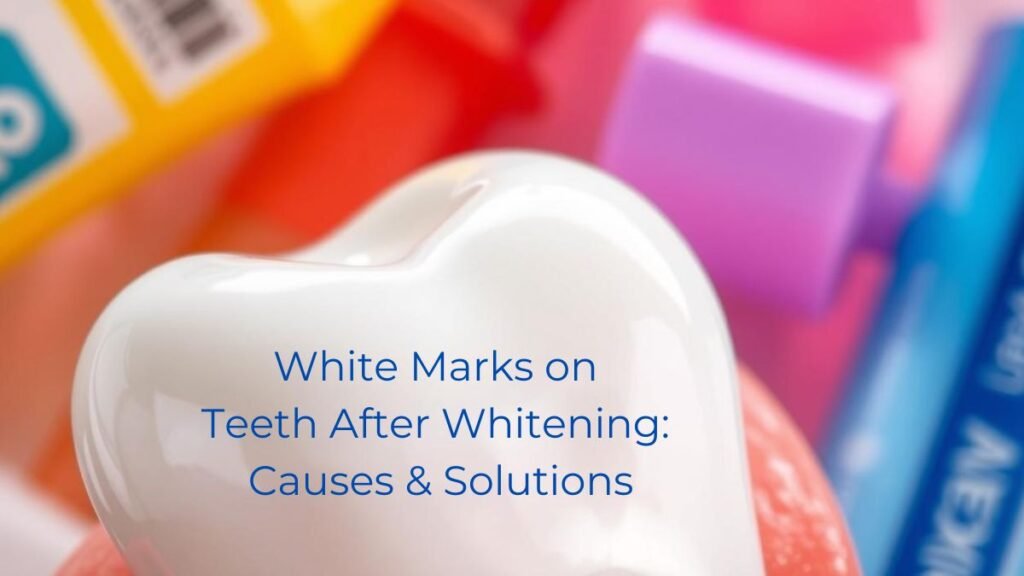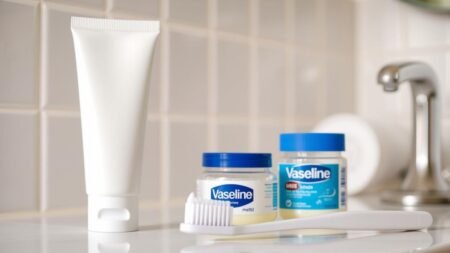Ever seen white marks on your teeth after whitening? You’re not alone. This is a common issue that can make you feel self-conscious. But what causes these white spots, and how can you fix them? Let’s find out.
White marks on teeth after whitening usually come from enamel demineralization. This is when the tooth’s outer layer loses important minerals. It happens when the whitening gel, which has hydrogen peroxide, softens and dehydrates the enamel.
Even though these white spots are usually temporary, they will go away as your teeth rehydrate. Knowing what causes them and how to solve the problem can help you avoid or fix this issue. So, what’s behind those white marks, and how can you get your smile back?
Enamel Demineralization and White Spots
Teeth whitening is a popular cosmetic procedure. But, it can sometimes lead to white marks or spots on the teeth. These marks are often due to enamel demineralization, where minerals are lost from the tooth’s outer layer.
What is Enamel Demineralization?
Enamel demineralization happens when the tooth’s outer layer weakens or thins. This can be caused by too much fluoride in childhood, leading to dental fluorosis. It can also be caused by poor dental hygiene, orthodontic treatment, or a diet full of acidic or sugary foods.
The Role of Hydrogen Peroxide in Whitening
The main ingredient in whitening gels is hydrogen peroxide. It breaks down stains and discoloration by penetrating the tooth enamel. But, this can temporarily soften and dehydrate the enamel, causing temporary tooth discoloration or post-whitening hypersensitivity.
Normal vs. Concerning White Marks
It’s key to tell normal, temporary white marks from more serious, lasting white spots. Normal white marks are streaks or patches that appear right after whitening and usually go away in a few days. But, lasting white marks could mean dental fluorosis or thinning enamel.
If white marks don’t fade in a week or two, see a dentist. They can figure out the cause and fix any problems.
Common Causes of White Marks on Teeth After Whitening
White marks on your teeth after whitening can come from many sources. Poor oral hygiene is a big one. If you don’t brush and floss, plaque and bacteria can cause white spots. Acidic foods and drinks, like citrus fruits and soda, can also erode enamel and lead to white marks.
Teeth grinding or clenching, known as bruxism, can wear down enamel. This makes teeth more likely to get white spots. Some medicines, like tetracycline antibiotics, can also discolor teeth and cause white marks.
- Poor oral hygiene
- Acidic foods and beverages
- Teeth grinding or clenching
- Certain medications
- Dental fluorosis (overexposure to fluoride)
- Removal of orthodontic appliances
Professional whitening side effects can make white marks more noticeable. But, the whitening treatment itself doesn’t cause these marks. Sometimes, removing orthodontic appliances can reveal white spots that were hidden before.
If you’re worried about enamel erosion or whitening sensitivity after whitening, talk to your dentist. They can find the cause and suggest ways to fix it. This will help keep your teeth healthy and looking good.
| Cause | Description |
|---|---|
| Poor Oral Hygiene | Plaque and bacteria buildup can lead to white spots on teeth. |
| Acidic Foods/Beverages | Consuming acidic items can contribute to enamel erosion and white marks. |
| Teeth Grinding/Clenching | This habit can wear down tooth enamel, making teeth more susceptible to white spots. |
| Certain Medications | Some medications, like tetracycline antibiotics, can discolor teeth and lead to white marks. |
| Dental Fluorosis | Overexposure to fluoride during tooth development can cause white spots. |
| Orthodontic Appliance Removal | Removing braces or other appliances can reveal pre-existing white spots. |
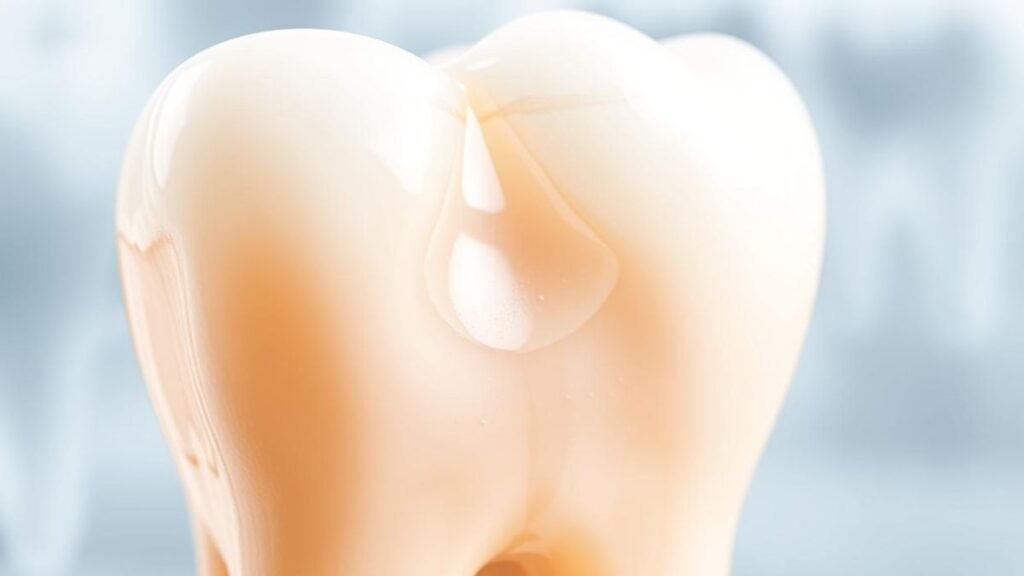
The Science Behind Post-Whitening Dehydration
White marks on teeth after whitening are often due to dehydration. This happens when hydrogen peroxide in whitening products pulls water from tooth enamel. This makes the enamel look more opaque, causing white spots or streaks.
How Dehydration Affects Tooth Enamel
Tooth enamel protects your teeth. When it gets dehydrated, it can lead to temporary tooth discoloration and whitening sensitivity. It also makes the enamel look like it’s losing minerals.
Timeline for Rehydration
The dehydration effect is usually short-lived. It takes 24 to 48 hours for the enamel to reabsorb minerals and moisture. This restores its normal look and function.
Signs of Normal Dehydration vs. Damage
During rehydration, you might feel some whitening sensitivity and see a uniform white on your teeth. This is normal and shouldn’t worry you. But, if white marks last more than 48 hours or sensitivity increases, it could be a sign of deeper tooth demineralization. You might need to see a dentist.
It’s important to follow your dentist’s care instructions after whitening. This helps with proper rehydration and reduces side effects. With the right care, you can keep your bright, beautiful smile without worrying about white marks.
Professional vs. At-Home Whitening Effects
There are two main ways to whiten your teeth: professional treatments or at-home products. Knowing the differences can help you choose what’s best for you and your teeth.
Professional treatments use strong hydrogen peroxide for quick results. But, this can also cause enamel erosion and whitening sensitivity. Dentists watch for these side effects and help prevent them.
At-home whitening kits have weaker ingredients. They take longer to work but are less likely to cause immediate problems. But, using them too much or wrong can damage your teeth and cause sensitivity.
| Professional Whitening | At-Home Whitening |
|---|---|
| Higher peroxide concentration | Lower peroxide concentration |
| Faster, more dramatic results | Gradual, less dramatic results |
| Higher risk of temporary sensitivity | Lower risk of temporary sensitivity |
| Professionally monitored | Self-administered |
| $300* or more on average | $20 to a few hundred dollars |
Choosing between professional and at-home whitening depends on your needs, budget, and dentist’s advice. Using them correctly and in moderation is important. This way, you can get the best results without the risks of professional whitening side effects, enamel erosion, and whitening sensitivity.
Treatment Solutions and Recovery Methods
If you’ve got white marks or stains on your teeth after whitening, don’t worry. There are many ways to get your teeth back to their natural shine. Knowing why these marks happen, like tooth demineralization or sensitivity after whitening, helps find the right solution.
Remineralization Techniques
Remineralization is a key method to fight white stains from whitening. It uses fluoride, calcium, and phosphate to fill in your enamel. You can use:
- Fluoride toothpaste or mouthwash
- Calcium and phosphate-rich foods like milk, cheese, and yogurt
- Professional fluoride varnish or gel
Using these products daily can make your enamel stronger and less noticeable.
Professional Dental Interventions
If stains don’t go away, your dentist might suggest professional treatments. These could be:
- Fluoride varnishes or gels for extra remineralization
- Dental bonding or veneers for covering white spots
- Microabrasion or enamel reshaping to hide discoloration
These treatments can make your teeth look great again and stop further damage.
Home Care Remedies
While your teeth heal, you can do a few things at home to help. This includes:
- Using a toothpaste with fluoride, calcium, and phosphate
- Drinking lots of water
- Avoiding foods and drinks that stain, like coffee and red wine, for 48 hours
By combining professional help with good home care, you can fix and prevent white marks. This will bring back your bright, confident smile.
Prevention Strategies and Best Practices
Keeping your teeth clean is key to avoiding white marks after whitening. Brush your teeth twice a day with toothpaste that has fluoride. Also, floss often to get rid of plaque and food bits. Use a soft-bristled toothbrush and brush gently to avoid harming your enamel.
Think about using a toothpaste or gel that helps strengthen your teeth. Your dentist might suggest this. If you grind your teeth, wearing a mouthguard can help protect your enamel.
Watching over your kids’ fluoride use is important to avoid dental fluorosis. This can cause white spots or streaks on their teeth. Always follow the directions on whitening products or what your dentist tells you.
Going to the dentist regularly is vital. They can spot and fix early signs of tooth damage or other issues. Your dentist can also give you tips on keeping your teeth healthy and looking good.
- Brush twice daily with fluoride toothpaste
- Floss once a day
- Use a soft-bristled toothbrush and avoid aggressive brushing
- Consider using a remineralizing toothpaste or gel
- Wear a mouthguard if you grind or clench your teeth
- Supervise children’s fluoride use to prevent dental fluorosis
- Follow all instructions for at-home or professional whitening treatments
- Schedule regular dental check-ups
By following these tips, you can keep your teeth healthy and white after whitening. This helps prevent problems like enamel erosion, sensitivity, and dental fluorosis.
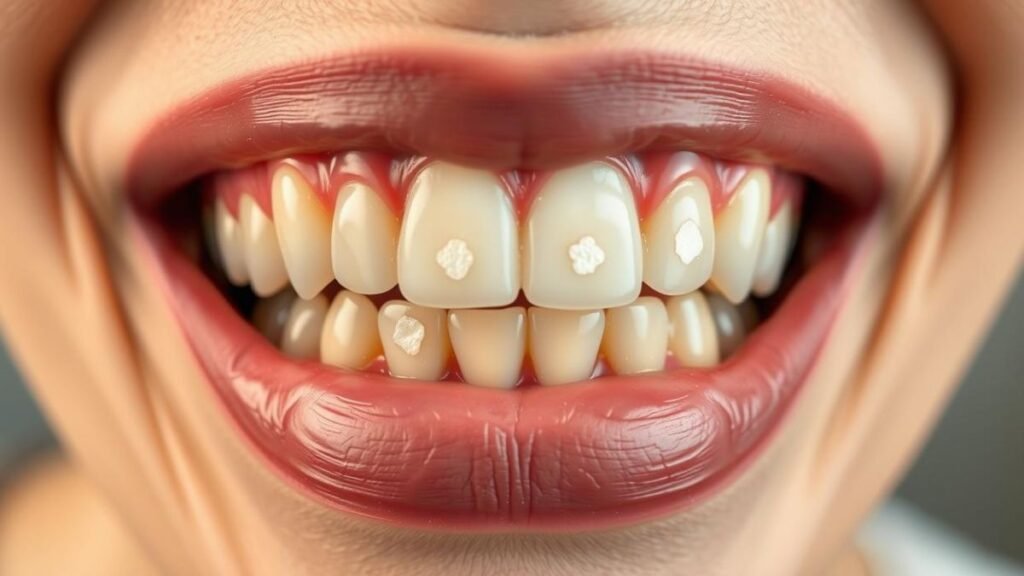
Conclusion
White marks on your teeth after whitening are usually a normal, temporary side effect. They happen because of demineralization and dehydration of the enamel. These issues usually go away in a few days as your teeth rehydrate and get minerals back.
If you have white stains from teeth whitening that don’t go away, it might mean there’s a dental problem. You should see a dentist to check it out.
To avoid white spots after whitening, follow the aftercare instructions well. Keep your teeth clean and healthy. If you’re worried about white marks, talk to your dentist. They can give you advice and treatment that’s right for you.
Keeping your smile bright is about more than just whitening. It’s about taking care of your teeth at home and getting professional help. A healthy lifestyle also helps keep your teeth strong. With the right care, you can have a beautiful smile without worrying about white marks.
Frequently Asked Questions
What causes white marks on teeth after whitening?
White marks on teeth after whitening come from enamel demineralization. This is when minerals in the enamel are lost. The whitening gel, with hydrogen peroxide, can soften and dry out the enamel, causing white marks.
Are these white marks a normal side effect of teeth whitening?
Yes, white marks or spots are common after teeth whitening. They usually go away in a few days as the teeth rehydrate and remineralize.
What other factors can contribute to white marks on teeth?
White marks can also come from poor oral hygiene, eating too much acidic food, grinding teeth, certain medications, and dental fluorosis.
How does post-whitening dehydration affect the appearance of teeth?
Dehydration from whitening products can make enamel look more opaque. This leads to temporary white spots or streaks. This dehydration usually goes away in 24-48 hours as the enamel gets moisture back from saliva.
What are the differences between professional and at-home whitening treatments regarding white marks?
Professional whitening uses stronger hydrogen peroxide, which might cause more white marks due to deeper dehydration. At-home products use weaker hydrogen peroxide, which might be less likely to cause white marks but take longer to work.
How can I prevent or treat white marks after whitening?
To avoid white marks, brush well, eat less acidic and sugary foods, and use a soft toothbrush. Use a remineralizing toothpaste or gel. For white marks, most spots improve in 24-48 hours. If spots last, see a dentist for possible treatments or to check for other issues.
